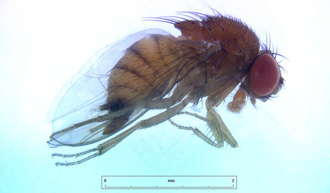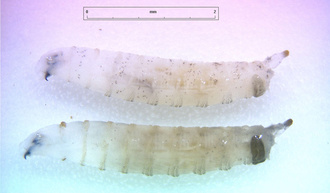Fruit Pest Drosophila suzukii arrives in Reunion
Written by Modified on the
Following a request from the french General Directorate for Food, the ANSES[1] (the National Agency for Food Safety, Environment and Work) recently published its report on the phytosanitary risks in Reunion concerning the fruit fly Drosophila suzukii. The agency announced the imminent arrival of this fruit fly in Reunion shortly before it was actually detected.
Drosophila suzukii, a Diptera[2] of Asian origin, attacks fleshy fruit to lay its eggs. Once hatched, the larvae feed on the flesh, causing significant production losses. Unlike other fruit flies, Drosophila suzukii has the distinction of being able to attack both damaged fruit as well as healthy fruits ... hence the substantial impact it has on fruit crops.
In 2012 CIRAD confirmed Reunion as being free of D. suzukii, however, a little over a year later, in November 2013, a specimen was officially identified for the first time on the island. Today, the predictions in the ANSES report are unfortunately being confirmed: Drosophila suzukii, dipteran pest of fruit trees, seems to be on track to settle permanently on the island
A favorable climate in Reunion, Mayotte not affected
The ANSES report unambiguously stated a very high risk of introduction of the Asian fruit fly to Reunion: transportation of fruits and vegetables by passengers on commercial airlines is unfortunately difficult to control. It is therefore likely that this route was the vector for the introduction of D. suzukii to Reunion. According to the ANSES, the fly prefers temperate climates, so introduction to Mayotte is unlikely as the island's climate is mainly tropical. Things are different in Réunion. There is a very pronounced relief, and higher areas, where temperatures are milder, correspond to the optimal conditions for the introduction and development of D. suzukii.
"In Réunion, risk of introduction of D. suzukii is likely,
due to a significant risk of entry [...] and risk of establishment
in upland areas where key host plants are grown. [...]"[3]
Strawberry, peach and Cayenne cherry crops directly affected
Of the crops in Réunion, strawberry and peach are popular hosts for the larvae of D. suzukii. In addition, there are serious concerns for Chinese guava[4] and the Cayenne cherry[5] which are directly affected by the fly.
However, ANSES has reservations regarding some of its forecasts. Indeed, the lack of data on the behavior of the fly in a tropical climate - particularly regarding its acclimatization and adaptation capacities - requires caution in prognosis. Nothing indicates that the fly will not settle on the coast or in mango orchards. We only know that the tropical climate prevailing on the coast does not match its ecosystem habits. In the same way, we have no data as to the possible consequences of its presence on tropical fruits.
Regarding the strawberry and peach, which are part of its known hosts, they are usually grown between 800 and 1500 meters in altitude. At this eight, the temperate climate is ideal for the diptera. Although strawberry and peach production is not of major economic importance for the island’s agriculture compared to banana or pineapple, the presence of the Drosophila could quickly become a critical issue for the farms affected.
The ANSES report contained a series of recommendations to prevent the introduction of this pest to Réunion.
Prevention is key
To protect the island from the introduction of D. suzukii, the main recommendations issued by ANSES concern imported plant material and weight. In its report, the agency called for the systematic cold treatment of fruit from known host plants and hoped for strict controls of plant material immediately after arrival on the island. The agency pointed out in passing that the introduction by passengers of plant material to Réunion is totally prohibited under a prefectural order dated September 25, 1992.
These methods alone are not enough to stem the risk of an introduction of D. suzukii. It is able to withstand winter in France, so it is likely that individuals or their eggs are not eliminated by cold treatment, not to mention the difficulty of systematic and effective control of imports. ANSES advocated and encouraged public awareness of the risks associated with the introduction of the species. Indeed, the involvement of local industry and the public is essential to the success of this plan.
As D. suzukii has been confirmed in Réunion, ANSES recommends maintaining phytosanitary import controls upon arrival - although they are difficult to implement given the fruit mass imported - as well as increased awareness and inspection of passengers. As well as these prophylactic measures, safety nets may be installed around at-risk crops to prevent the flies laying their eggs inside the fruit. On Mayotte, which is at a lower risk, ANSES recommends regular monitoring of crops to detect the possible arrival of D. suzukii in the territory.
Read more:
[1]
ANSES is an agency performing on-demand independent scientific expertise and assessment of health, food or environmental risks.
[2]
With more than 150,000 described species, the order Diptera is characterized by the possession of a single pair of membranous wings (di: two; pteron: wing).
[3]
Risk analysis for Drosophila suzukii for Reunion. ANSES Notice, July 2014.
[4]
Source: Philippe Thomas, Head of the DAAF Plant Health Unit (Directorate for Food, Agriculture and Forestry) of Reunion.
[5]
ANSES's report mentions concerns about the potential impact of D. suzukii on the production of Cayenne cherry.



